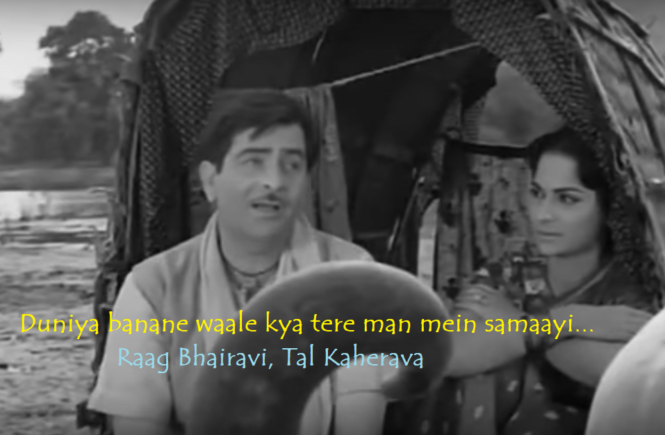Raaga Based Song of the Day: Duniya banane waale kya tere man mein samaayi….
Raag Bhairavi, Tal Kaherava
A few days ago, I had mentioned that time had come for me to give you songs in the favourite raaga of Shankar Jaikishan (especially Jaikishan, who named his daughter Bhairavi, the name of his favourite raaga). Since then, I have given you, two of their compositions: Sab kuchh seekha hamane (the title song of Anaadi; please see: ‘Raaga Based Song Of The Day #79‘) and O sahama mujhe phoonk de (Aashiq; Please see: ‘Raaga Based Song Of The Day #81‘).
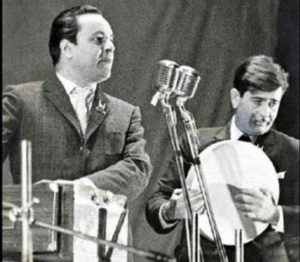
Today’s song too has been sung by Mukesh, the singer of the last Raaga Based Song Of The Day #84 when we broke off on 20 Oct 17. Mukesh sang for many actors but no one more than Raj Kapoor who called him his ‘Singing Voice’. Some of the memorable songs that Mukesh sang for Raj Kapoor are: Aaja re ab mera dil pukaara, Zindaa hoon is tarah ke gham-e-zindagi nahin (Aah, 1953 and 1948), Aansu bhari hain ye jeevan ki raahen (Parvarish, 1958), Awara hoon (title song of 1951 movie Awara), Ai sanam jisane tujhe chand si surat di hai (Diwana, 1967), Begaani shaadi mein Abdullah deewana, Hontho pe sachayi rehati hai, Mera naam Raju gharaana anaam, Pyaar kar le nahin to phansi chad jaayega (Jis Desh Mein Ganga Behti Hai, 1960), Bhule se mohabbat kar baitha, Tum agar mujhako naa chaho to koi baat nahin, Tumhaari mast nazar gar idhar nahin hoti (Dil Hi To Hai, 1963), Dam bhar jo udhar moonh phere, Ham tujh se mohabbat karke sanama, (Awara, 1951), Dil ki nazar se, Kisi ki muskraahton pe ho nisaar, Sab kuchh seekha hamane (Anaadi, 1959), Dost dost na raha, Har dil jo pyaar karega, Mere man ki Ganga aur tere man ki Jamuna ka (Sangam, 1964), Hamane tujhako pyaar kiya hai jitana, Mujhe kehte hain Kallu Qawaal (Dulha Dulhan, 1964), Ik din bik jaayega maati ke mol (Dharam Karam, 1975), Jane kahan gaye woh dil, Jeena yahan marna yahan, Kehta hai Joker saara zamaana (Mera Naam Joker, 1970), Jaane na nazar pehchaane jigar (Aah, 1953), Khayalon mein kisi ke is tarah aaya nahin karte (Bawre Nain, 1950), Kuchh shair sunaata hoon main (Ek Dil Sau Afsaane, 1963), Mehtaab tera chehra, O shama mujhe phoonk de (Aashiq, 1962), Ramaiyya vastavaiyya (Shree 420, 1955), Mere toote huye dil se (Chhaliya, 1960), Mujhako yaaro maaf karna main nashe mein hoon (Main Nashe Main Hoon, 1959), Mujhe tumase kuchh bhi na chahiye, Ruk jaa o jaanewali ruk jaa, Yaad aayi aadhi raat ko (Kanhaiya, 1959), Sajan re jhoot mat bolo, Sajanvaa bairi ho gaye hamaar (Teesri Kasam, 1966), and Wo subah kabhi to aayegi (Phir Subah Hogi, 1958). With so many memorable songs no wonder that Raj Kapoor held Mukesh as responsible for his success as an actor.
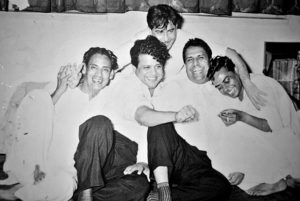
The lyricist Hasrat Jaipuri has been called as the King of Romance. He has given us the best of songs on Love and Romance. This is a philosophical song and hence an exception for him. He really put his heart and soul into the song. The movie wasn’t a success at post office. This broke his fellow lyricisr Shailendra’s heart to the extent that he took to heavy drinking, which ultimately led to his death. Hasrat addressed the present song to the Creator Himself and questioned Him in His motive in making the duniya (world). I often marvel at his bent of mind in the last stanza:
Priit banaake tuune jiinaa sikhaayaa, ha.nsanaa sikhaayaa,
Ronaa sikhaayaa
Jiivan ke path par miit milaae
Miit milaake tuune sapane jagaae
Sapane jagaake tuune, kaahe ko de dii judaaI
Kaaheko duniyaa banaaI, tuune kaaheko duniyaa banaaI
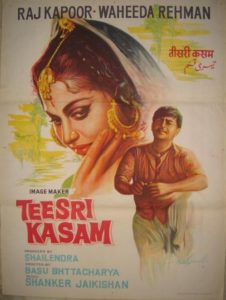 Indeed, this type of deep thinking is true of all songs of the 1966 movie Teesri Kasam. Shailendra had Basu Bhattacharya direct the movie. In later years (after the movie flopped at Box Office), people realised what a masterpiece it was. In any case, it won the National Award for Best Feature Film of that year. The film starring Raj Kapoor (there is a controversy about him delaying the film to ensure the success of his 1964 movie Sangam) and Waheeda Rehman is based on the short story Mare Gaye Gulfam by the novelist Phanishwarnath Renu. Mare gaye gulfam was also the title of a song in the movie and was also penned by Hasrat Jaipuri:
Indeed, this type of deep thinking is true of all songs of the 1966 movie Teesri Kasam. Shailendra had Basu Bhattacharya direct the movie. In later years (after the movie flopped at Box Office), people realised what a masterpiece it was. In any case, it won the National Award for Best Feature Film of that year. The film starring Raj Kapoor (there is a controversy about him delaying the film to ensure the success of his 1964 movie Sangam) and Waheeda Rehman is based on the short story Mare Gaye Gulfam by the novelist Phanishwarnath Renu. Mare gaye gulfam was also the title of a song in the movie and was also penned by Hasrat Jaipuri:
| 1. | “Aa Aa Bhi Jaa” | Shailendra | Lata Mangeshkar | 5:03 |
| 2. | “Chalat Musafir” | Shailendra | Manna Dey | 3:04 |
| 3. | “Duniya Bananewale” | Hasrat Jaipuri | Mukesh | 5:03 |
| 4. | “Haye Ghazab Kahin Tara Toota” | Shailendra | Asha Bhosle | 4:13 |
| 5. | “Maare Gaye Gulfaam” | Hasrat Jaipuri | Lata Mangeshkar | 4:00 |
| 6. | “Paan Khaye Saiyan Hamaaro” | Shailendra | Asha Bhosle | 4:08 |
| 7. | “Sajanwa Bairi Ho Gaye Hamar” | Shailendra | Mukesh | 3:51 |
| 8. | “Sajan Re Jhoot Mat Bolo” | Shailendra | Mukesh | 3:43 |
| 9. | “Lali Lali Doliya Mein Lali Re” | Shailendra | Asha Bhosle | 3:11 |
| 10. | “Kissa Hota Hai Shuru” | Hasrat Jaipuri | Shankar-Shambhu | 2:57 |
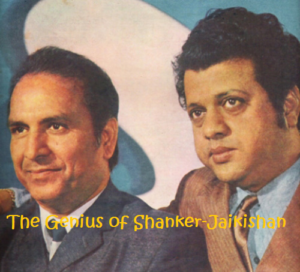 Music Director Shankar Jaikishan were called the ‘house musicians’ of Raj Kapoor since the latter was responsible for having given them a break with his 1949 movie Barsaat. In the movie before that (the debut movie of Raj Kapoor as a director, the 1948 movie Aah, Shankar Jaikishan were assistants to music director Ram Ganguly. Raj Kapoor had a tiff with Ram Ganguly and hence invited S-J for Barsaat. The rest is history. Until Jaikishan died on 12 Sep 1971, Shankar Jaikishan had won the Filmfare Award for Best Music Director eight times (including for Mera Naam Joker in 1972). Considering that the Filmfare Award for Best Music Director started in 1954, it makes them win the coveted award on an average of every alternate year. Raj Kapoor maintained a music bank of their compositions even after Jaikishan died and in his later movies used those compositions though the credit was given to music directors such as Laxmikant Pyarelal.
Music Director Shankar Jaikishan were called the ‘house musicians’ of Raj Kapoor since the latter was responsible for having given them a break with his 1949 movie Barsaat. In the movie before that (the debut movie of Raj Kapoor as a director, the 1948 movie Aah, Shankar Jaikishan were assistants to music director Ram Ganguly. Raj Kapoor had a tiff with Ram Ganguly and hence invited S-J for Barsaat. The rest is history. Until Jaikishan died on 12 Sep 1971, Shankar Jaikishan had won the Filmfare Award for Best Music Director eight times (including for Mera Naam Joker in 1972). Considering that the Filmfare Award for Best Music Director started in 1954, it makes them win the coveted award on an average of every alternate year. Raj Kapoor maintained a music bank of their compositions even after Jaikishan died and in his later movies used those compositions though the credit was given to music directors such as Laxmikant Pyarelal.
S-J emerged as the toppers in various genre of music such as raaga based songs, party songs, and dance numbers. Amongst all the raagas, Bhairavi was their (Jaikishan’s) favourite.
Their music and compositions for the 1956 Raja Nawathe film Basant Bahaar (surprisingly they didn’t get Filmfare Award for it as they were competing with their own Chori Chori) have some of their best raaga based songs:
| 1 | Badi Der Bhai (Pilu) |
Mohd. Rafi |
| 2 | Bhay Bhajana Vandana Sun (Mian ki Malhar) | Manna Dey |
| 3 | Duniya Na Bhaye (Todi) |
Mohd. Rafi |
| 4 | Ja Ja Re Ja Balama (Jhinjhoti) |
Lata Mangeshkar |
| 5 | Kar Gaya Re | Lata Mangeshkar, Asha Bhosle |
| 6 | Ketaki Gulab Juhi (Basant Bahar) |
Manna Dey, Bhimsen Joshi |
| 7 | Main Piya Teri | Lata Mangeshkar |
| 8 | Nain Mile Chain Kahan | Lata Mangeshkar, Manna Dey |
| 9 | Sur Na Saje (Pilu) |
Manna Dey |
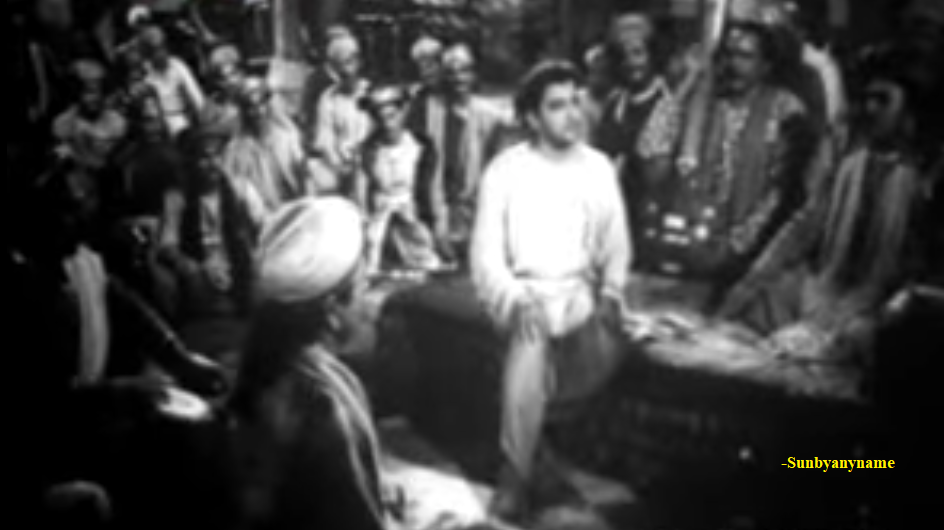
We have completed eighty-two days of Raaga Based Songs of the Day. Our first post in the series was titled ‘Raaga Based Song Of The Day #1’ and the song was a Mohammad Rafi and Lata Mangeshkar song from the 1970 Shakti Samanta movie Pagla Kahin Ka: Tum mujhe youn bhula na paoge. It is in Raag Jhinjhoti, Tal Kaherava.
Our eighty-fourth post or the last post was titled ‘Raaga Based Song Of The Day #84’ and the song was a Mukesh song from the 1962 SN Tripathi movie Sangeet Samrat Tansen starring Bharat Bhushan in the title role and Anita Guha as his beloved Hansa: Jhumati chali hawa yaad aa gaya koi. It is in Raag Sohani, Tal Dadra.
This blog has a number of posts on Raaga based songs in Hindi movies titled similarly; for example: ‘The Best Raaga Based Songs in Hindi Movies – Raaga Jhinjhoti – Part II’.
In the last eighty-four days of sharing Raaga based songs of the day, I have given you songs based on Raag Jhinjhoti, Gara, Bhimpalasi, Madhuvanti, Shivaranjani, Bihag, Pahadi, Sarang, Pilu, Bhairavi, Khammaj, Charukesi, Kalyan or Yaman, Desh, Malgunji, Kirwani, Kedar, Bageshri, Megh Malhar, Bhupali, Ahir Bhairav, Malkaush, Mand, Adana, Kafi, Rageshri, Jaunpuri, Tilang, Janasammohini, Chayanat, Shuddha Kalyan, Gaur Sarang, Jogiya, Asavari, Maru Bihag, Durga, Lalit, Puria Dhanashri, Bhinna Sahdja, Sohani, Multani, Patdeep, Jaijaiwanti, Tilak Kamod, Hemant, Basant Mukhari, Gujri Todi, Kalavati, Hamir, Bhatiyar, Gawati, Shyam Kalyan, Gorakh Kalyan, Madhamat Sarang, Manj Khammaj, Darbari Kanada, Vibhas, Shankara, Bahar, Nand and Mian Ki Malhar; making it a total of 61 raagas. The raagas that have been repeated so far are Pahadi, the raaga of my home place in the Himalayas, Maru Bihag, Raag Kirwani, Jhinjhoti, Bhairavi, Gara, Basant Mukhari, Malkauns, Bhairavi, Mand and Sohani. Today, I am repeating Raag Bhairavi for the seventh time.
Today’s song has been sung by Mukesh on the lyrics of Shailendra and composition by Shankar Jaikishan. As I said, it is in Raag Bhairavi, Tal Kaherava. The song is picturised on Raj Kapoor as Hiraman in the 1966 Basu Bhattacharya movie Teesri Kasam, a Shailendra production.
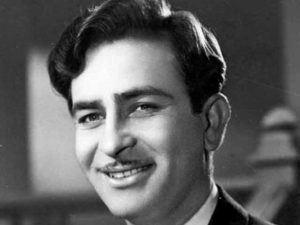
At this stage, letss take up Raj Kapoor, the actor, producer and director. He was known as the greatest showman in Indian Cinema. He was born on 14 Dec 1924 in Kapoor Haveli in Peshawar (now in Pakistan). He died on 02 Jun 1988 at the age of 63 years. Before that, in 1987, he was conferred with the highest award in Indian Cinema: the Dadasaheb Phalke Award. In 1971, he was also awarded Padma Bhushan. He won three National Awards and eleven Filmfare Awards. Filmfare Lifetime Achievement Award is named after him. Raj Kapoor made 18 movies with Shankar Jaikishan as Music Director, Shailendra and Hasrat Jaipuri as lyricists. This Teesri Kasam song is with Waheeda Rehman. However, the actress with whom he acted in most movies (16 of them) was Nargis.
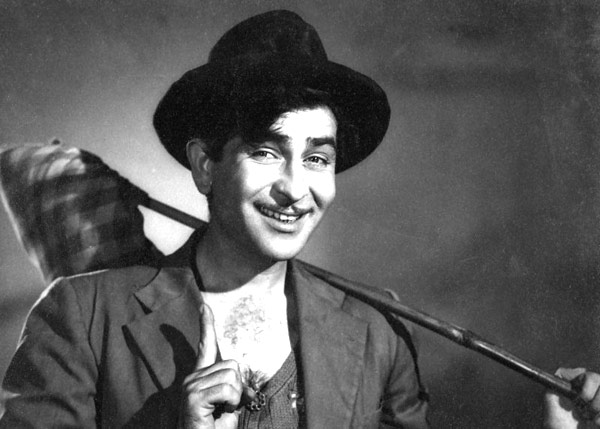
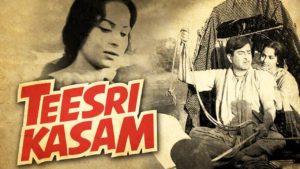 Lets get to the movie: Teesri Kasam. As I said, this 1966 movie was the first and last production of the lyricist Shailendra and directed by Basu Bhattacharya. Basu Bhattacharya started as an assistant to Bimal Roy in Madhumati and Sujata and later married Bimal Roy’s daughter Rinki. Some of his memorable movies are: Anubhav, Aavishkar, Sparsh, Aastha and Griha Pravesh. It is the story of a naive bullock cart driver Hiraman (Raj Kapoor) who falls in love with a dancer Hirabai (Waheeda Rehman) at nautanki, the popular folk theatre of the Bihar region. Hiraman takes two vows based on difficult situations in his life. After he meets and befriends Hirabai, a nautanki dancer, who is a passenger in his bullock cart, he takes a third vow never to get himself involved in such love again. And that’s why the name of the movie.
Lets get to the movie: Teesri Kasam. As I said, this 1966 movie was the first and last production of the lyricist Shailendra and directed by Basu Bhattacharya. Basu Bhattacharya started as an assistant to Bimal Roy in Madhumati and Sujata and later married Bimal Roy’s daughter Rinki. Some of his memorable movies are: Anubhav, Aavishkar, Sparsh, Aastha and Griha Pravesh. It is the story of a naive bullock cart driver Hiraman (Raj Kapoor) who falls in love with a dancer Hirabai (Waheeda Rehman) at nautanki, the popular folk theatre of the Bihar region. Hiraman takes two vows based on difficult situations in his life. After he meets and befriends Hirabai, a nautanki dancer, who is a passenger in his bullock cart, he takes a third vow never to get himself involved in such love again. And that’s why the name of the movie.
Before we actually take up the song, first, lets take up the value added learning of today. From the last four times onwards we started learning about some of the leading personalities in Indian Classical Music or Shastriya Sangeet. The first one that we took up was Ustaad Asad Ali Khan, the finest Rudra Veena player in the country. Then we took up Pandit Hari Parsad Chaurasia, the greatest Bansuri player in the country. Then we talked about Ali Akbar Khan, the greatest Sarod player in the country. And finally we took up Pandit Ravi Shankar, the greatest Sitar player in the world. Today, we shall take up the greatest classical singer in the country (of Carnatic tradition): MS Subbulakshmi.
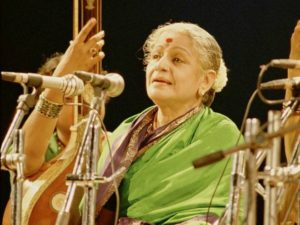
MS Subbulakshmi lived between 16 Sep 1916 and 11 Dec 2004. She was the first music personality to be awarded the highest award: the Bharat Ratna. She was also the first Indian musician to receive the Ramon Magsaysay Award, considered the Nobel Prize of Asia.
MS Subbulakshmi was born on September 16, 1916 in Madurai, to Veena player Shanmukavadiver Ammal and Subramania Iyer. Her grandmother Akkammal was a violinist. She started learning Carnatic music at an early age and trained in Carnatic music under the tutelage of Semmangudi Srinivasa Iyer and subsequently in Hindustani music under Pandit Narayanrao Vyas. She gave her first performance at the age of 11 in the year 1927. This was inside the 100 pillars hall of Rockfort temple in Trichurapalli.
By the age of seventeen, Subbulakshmi was giving concerts on her own, including major performances at the Madras Music Academy.
She travelled to London, New York, Canada, the Far East, and other places as India’s cultural ambassador. Her concerts at
- Edinburgh International Festival of Music and Drama in 1963
- Carnegie Hall, New York; the UN General Assembly on UN day in 1966
- Royal Albert Hall, London in 1982
- Festival of India in Moscow in 1987
were significant landmarks in her career.
As far as films are concerned, she acted in Tamil films in her youth, the 1938 movie Sevasadanam being her first one. She also played the male role of Narada in Savitri (1941) to raise money for launching Kalki, her husband’s nationalist Tamil weekly. Her title role of Meera in the 1945 film gave her national prominence. This movie was re-made in Hindi in 1947.
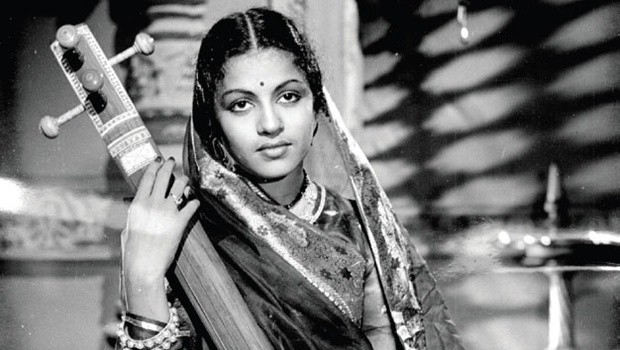
As I said, today’s song is in Raag Bhairavi, Tal Kaherava.
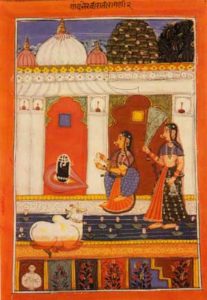
Raag Bhairavi is the basic raag of the Bhairavi Thaat. Bhairavi makes use of all the komal swars, Rishabh, Gandhar, Dhaivat, Nishad. When singing compositions in Bhairavi raag, the singers however take liberty to use all the 12 swars. Bhairavi raag is named after the Shakti or feminine aspect of the cosmic life force, which is personified as a consort to Lord Shiva. Bhairavi is a powerful raag filled with devotion and compassion. Its Jati is Sampurna – Sampurna, which means all seven swar (heptatonic) both in Aaroha and Avaroha. I have already told you that in a concert Bhairavi is usually the concluding raaga since it is supposed to cure mistakes of the earlier performances. Hence, if a concert has started at night (which is usually the case), Bhairavi would be played in the wee hours of the morning.
A pleasant sobering atmosphere full of love and piety is created with this raag and one feels so close to the Supreme. Its compositions include several Thumris, Bhajans, Ghazals, Songs etc. Since it is an ocean of immense possibilities the melodic combinations can include all the twelve notes with skill.
I am not giving you again a list of songs composed in Raag Bhairavi as I have already given you this adequate number of times, this being the seventh time I am giving you a song in this raag.
About Tal Kaherava, I told I have already told you adequately, this being the most commonly used Tal.
Please enjoy in Raag Bhairavi, Tal Kaherava: Duniya banane waale kya tere man mein samaayi….
(duniyaa banaane vaale, kyaa tere man me.n samaaI
kaaheko duniyaa banaaI, tuune kaaheko duniyaa banaaI ) – 2
kaahe banaae tuune maaTii ke putale,
dharatii ye pyaarii pyaarii mukha.De ye ujale
kaahe banaayaa tuune duniyaa kaa khelaa – 2
jisame.n lagaayaa javaanii kaa melaa
gup-chup tamaashaa dekhe, vaah re terii khudaaI
kaaheko duniyaa banaaI, tuune kaaheko duniyaa banaaI …
tuu bhii to ta.Dapaa hogaa man ko banaakar,
tuufaa.n ye pyaar kaa man me.n chhupaakar
koI chhavi to hogii aa.Nkho.n me.n terii – 2
aa.Nsuu bhii chhalake ho.nge palako.n se terii
bol kyaa suujhii tujhako, kaaheko priit jagaaI
kaaheko duniyaa banaaI, tuune kaaheko duniyaa banaaI …
priit banaake tuune jiinaa sikhaayaa, ha.nsanaa sikhaayaa,
ronaa sikhaayaa
jiivan ke path par miit milaae – 2
miit milaake tuune sapane jagaae
sapane jagaake tuune, kaahe ko de dii judaaI
kaaheko duniyaa banaaI, tuune kaaheko duniyaa banaaI …
We have intended to learn about Raaga based music whilst we entertain ourselves with Raaga based songs. So, lets, once again, take stock of our collective learning so far:
- On the first day we learnt about the Raaga system devised by Pandit Vishnu Narayan Bhatkhande, which is the prevalent system in Hindustani Classical Music and based on ten Thaats.
- On the second day we learnt about Tal or Taal.
- On the third day we learnt about characteristics of Raagas that included Swar, Jati, Thaat, Arohana and Avarohana, Vadi, Samvadi and Pakad.
- On the fourth day, we learnt about Sargam.
- On the fifth day, we learnt about notations used in Indian classical music or simply Swar Lipi.
- On the sixth day, we learnt about the Ras (sentiments) that Raagas evoke.
- On the seventh day, we learnt about various types of Swar: Shuddha, Achal, Vikrut, Komal and Teevra.
- On the eighth day, we learnt the parts of a composition in Indian Classical Music.
- On the ninth day, we learnt the names of some of the popular instruments used in Indian Classical Music.
- On the tenth day, we learnt about the sources of names of Raagas.
- On the eleventh day, we learnt about why Bhairavi is the first raag to be taught to beginners and also why it is the last in a performance.
- On the twelfth day, we learnt about Khammaj Thaat.
- On the thirteenth day, we learnt about Tal Punjabi Theka or Sitarkhani.
- On the fourteenth day, we learnt about Alap.
- On the fifteenth day, we learnt about List of Raagas (Raagmala) in my favourite book: Sri Guru Granth Sahib.
- On the sixteenth day, we learnt about tips for raaga identification.
- On the seventeenth day, we learnt the basics of Gharana system.
- On the eighteenth day, we learnt about Filmi Sangeet.
- On the nineteenth day, we learnt about the commonest Tal in Raagas: Tintal.
- On the twentieth day, we learnt about the Kafi Thaat.
- On the twenty-first day, we learnt a little more in detail about the classification of Raagas.
- On the twenty-second day, we learnt the essential differences between Bhairavi and Bhairav.
- On the twenty-third day, we learnt a little more in detail about the Jati or Jaati of a raaga.
- On the twenty-fourth day, we learnt details of Thaat Bilawal, the most basic thaat in the Bhatkhande’s system of raagas.
- On the twenty-fifth day, we learnt about Tintal.
- On the twenty-sixth day, we learnt in detail about the Raaga – Samay linkage.
- On the twenty-seventh day, we learnt about Lehar.
- On the twenty-eighth day, we learnt about the history of the Hindustani Music.
- On the twenty-ninth day, we learnt about Dhrupad.
- On the thirtieth day, we learnt about Rupaktal that I was introduced to, a few months back, by my friend Anand Desai.
- On the thirty-first day, we learnt about Khayal.
- On the thirty-second day, we learnt about Thumri.
- On the thirty-third day, we learnt about Tappa.
- On the thirty-fourth day, we learnt about Tarana.
- On the thirty-fifth day, we learnt about Tal Dipchandi (Moghali).
- On the thirty-sixth day, we learnt about Tabla.
- On the thirty-seventh day, we learnt about Kirtan.
- On the thirty-eighth day, we learnt about Pakhawaj.
- On the thirty-ninth day, we learnt about Hori.
- On the fortieth day, we learnt about Dadra.
- On the forty-first day, we learnt about Kajri.
- On the forty-second day, we learnt about Chaiti.
- On the forty-third day, we learnt about Sarangi.
- On the forty-fourth day, we learnt about Shehnai.
- On the forty-fifth day, we learnt about Sarod.
- On the forty-sixth day, we learnt about Bansuri.
- On the forty-seventh day, we learnt about Ektal and Tanpura.
- On the forty-eighth day, we learnt about Veena.
- On the forty-ninth day, we repeated our learning of Veena with a small excitement added.
- On the fiftieth day, we learnt about Dilruba/Esraj.
- On the fifty-first day, we learnt about Jaltarang.
- On the fifty-second day we learnt about Qawwali.
- On the fifty-third day, we learnt about Sitar.
- On the fifty-fourth day, we learnt about Surbahar.
- On the fifty-fifth day, we learnt about Harmonium.
- On the fifty-sixth day, we learnt about Santoor.
- On the fifty-seventh day, we learnt about Swarmandal.
- On the fifty-eighth day, we learnt about the Shruti Box.
- On the fifty-ninth day, we learnt about Alankar.
- On the sixtieth day, we learnt about singing in Aakaar.
- On the sixty-first day, we learnt about the Classification of Indian Musical Instruments.
- On the sixty-second day, we learnt a little about Carnatic Music.
- On the sixty-third day, we learnt about Natya Shastra.
- On the sixty-fourth day, we learnt about evolution of musical instruments in India down the ages.
- On the sixty-fifth day, we learnt about Riyaaz.
- On the sixty-sixth day, we looked at a list of Raagas in Hindustani Classical Music.
- On the sixty-seventh day, we learnt about the health benefits of raagas.
- On the sixty-eighth day, we learnt a little more comprehensively about the moods and emotions that raagas evoke.
- On the sixty-ninth day, we learnt about a mobile application to help identify raagas.
- On the seventieth day, we learnt about Melakarta Raagas.
- On the seventy-first day, we learnt about Sangita Makarand.
- On the seventy-second day, we learnt about TaalMala an Android application for personalized accompaniment of musical instruments during Riyaaz or even during Concert.
- On the seventy-third day, we learnt about Indian Classical Ragas, an Android application for mobile phones.
- On the seventy-fourth day, we learnt about Saregama Classical, another application for Classical Raagas.
- On the seventy-fifth day, we learnt about a free online service available to learn Indian Classical Music.
- On the seventy-sixth day, we learnt about List of Hindustani Classical Musical Festivals in India and Abroad.
- On the seventy-seventh day, we learnt about List of Carnatic Musical Festivals in India and Abroad.
- On the seventy-eighth day, we learnt about Jhaptal.
- On the seventy-ninth day, we learnt about Ektal.
- On the eightieth day, we learnt about Tivra Tal.
- On the eighty-first day, we learnt about the greatest Rudra Veena player ever: Ustaad Asad Ali Khan.
- On the eighty-second day, we learnt about the greatest Bansuri player alive: Pandit Hariprasad Chaurasia.
- On the eighty-third day, we learnt about the best Sarod player in the country: Ustaad Ali Akbar Khan.
- On the eighty-fourth day, we learnt about the greatest Sitar player in the world: Pandit Ravi Shankar.
- And today, on the eighty-fifth day, we learnt about the greatest Indian vocalist of Carnatic tradition: MS Subbulakshmi.
There is much more still to be learnt and enjoyed.
Please stay tuned!
